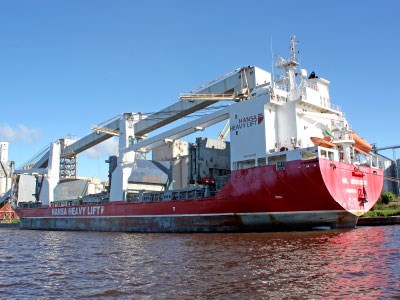The coming winter freeze-up on the Great Lakes means a rush of foreign-flagged and domestic shipping into the Port of Thunder Bay for the annual late-season grain haul.
October proved to be another strong month for shipments of wheat and canola, according to the port authority.
The year-to-date tonnage for the month was 23 per cent higher – at 5.7 million tonnes – than the five-year average of 4.6 million tonnes.
Wheat and canola dominate the port’s commodities, making up 94 per cent of the grain shipped through the port. An emerging commodity is lentils, a specialty crop which make up two per cent of shipments moved this year.
Compared to the monster grain hauls of the previous two years, this year’s harvest from Western Canada is a tad smaller, said port authority CEO Tim Heney, but because the harvest was earlier, grain has reached the port sooner.
By the end of October, more than 5.6 million tonnes of wheat and canola had arrived in port, slightly down from the 6.3 million recorded during the same period last year.
“It’s busy, and it’s going to be that the way until the end of shipping season,” said Heney.
Ocean-going ships have been arriving in abundance with 15 “salties” making port calls during the month, loading a combined total of 260,000 tonnes of grain destined for Europe, North Africa, the Middle East and Latin America.
The authority was expecting more than 20 salties to arrive during November.
It’s been called an “exceptional” year for general cargo with shipments through Keefer Terminal up three-fold over the five-year average.
Heney said there’s been a diverse haul of wind turbine components, mining equipment headed for the New Gold project near Fort Frances, imported Norwegian wood pellets for the Thunder Bay Generating Station, and the usual stream of modules, reactors and other equipment going to the Alberta oilsands.
A new and trending cargo is the arrival of three shipments of structural steel this year, used in building construction in Western Canada.
“We’ll take credit for that,” Heney said. “We went out after the steel ourselves and put that (shipment) together with the (steel) producer, railroad, and shipping company. It was quite a process to get that working well.”
With the European economy struggling, more foreign-flagged ships are on the lakes chasing cargo.
“With more steel going in the U.S., it’s brought those ships in,” said Heney, making for some very competitive rates buoyed by the low Canadian dollar.
Last year, it spurred a new transatlantic marine service to Europe formed by Spiethoff Group of Amsterdam.
Pioneered by the Port of Cleveland, Spiethoff’s nimble ships are cruising the lakes, unloading and picking up small cargoes at various ports.
The Spiethoff ships have made three calls into Thunder Bay this year with inbound electrical transformer equipment and mining parts for Western Canada. Heney expects more visits next year, particularly if grain cargoes can be arranged on the backhaul.
“They’ve provided a service and proved it can work. There’s been cargo moving on other supply chains that’s been attracted to the Seaway. As long as people see it’s there, they’ll start to use it.”
The closing date of the Welland Canal usually dictates how late the Port of Thunder Bay stays open. Heney said most salties are off the Great Lakes by Christmas. Lake freighters continue to sail until the Sault Locks close in mid-January.




